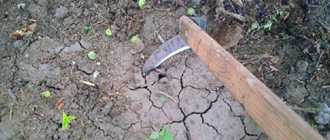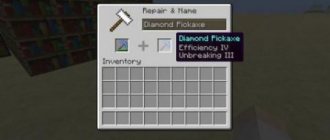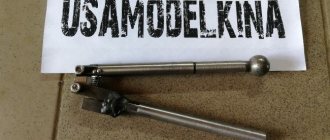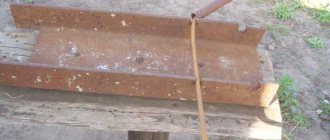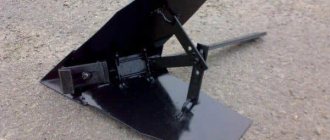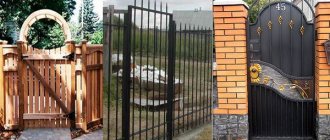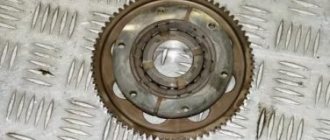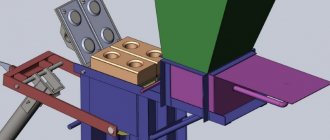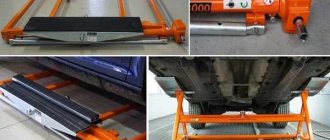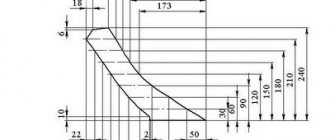Types of flat cutters and their application
The industrial production of flat cutters, which began at the end of the last century, will satisfy any need of a summer resident or gardener. Depending on what kind of work is planned, one of six models is selected.
All work in the garden and vegetable garden can be performed by one of those proposed in the list. But then the principle of using this tool – easily and efficiently – will be violated.
A flat cutter will help, but on the condition that each model will be used for its intended purpose.
- Small flat cutter - for working on light soil, when forming furrows and small beds, for sowing vegetable seeds, weeding and fine loosening.
- Large – formation of large ridges and seeding furrows on heavy soils. Planting crops using seedling method. Loosening to a depth of more than ten centimeters. Formation of tree trunk circles, first hilling of plants in the early phases of growth.
- Small wedge – quick processing of narrow row spacing. The working part of the tool is narrow, sharply sharpened.
- A large weed is a tool with a strong, sharp blade for weeding crops that occupy large areas.
- Moguschnik – has the widest blade, convenient for hilling vegetable crops.
- Strong - a wide but short blade allows you to process heavy, rocky soils.
To process one crop, in different growth phases, it is possible to use different models. If a Small Flat Cutter is suitable for planting carrot or beet seeds, then in the future, for weeding and loosening the rows of these same crops, you will need a large or small Polotik.
An important condition is the correct use of the tool. If certain rules are not followed, working with a flat cutter will differ little from working with an ordinary hoe or hoe.
Points to consider:
- The stalk should be rectangular with rounded edges.
- The cutting should “fit” in your hand. When gripping, the fingers should “look” up. If the diameter of the handle is large, it will be difficult to work with such a tool.
- The length of the cutting is selected according to the height of the person. A short handle will force you to work while bending over, while a long handle will not allow you to hold the tool at the required angle.
- The metal part is attached to the handle at an angle of 45°. Industrial models have ready-made technical holes. This point is important to consider when making a flat cutter yourself.
- The tool must be well sharpened. It is easier to work with a sharp tool.
The main principle is the horizontal direction of movement of the tool at a given depth. In this case, both rules will be observed: work will be easy, and the quality and speed of work will be high.
Types and features
Jigsaw saws for metal types and selection rules
Manufacturers offer several options for flat cutters. The choice is made taking into account the composition and type of soil on the site, as well as the upcoming work.
Using a large flat cutter, beds are prepared and furrows are cut for planting. The weight and size facilitate easy and quick weeding of rows, hilling, cutting down large weeds, and deep loosening of the soil. The model will replace the scythe in hard-to-reach places, for example, around bushes and trees. Tedding hay clippings while drying and mixing small volumes of mortar are unusual uses.
The small flat cutter looks like a large model, but with smaller dimensions. Useful for processing row spacing and vegetable beds. Light weight allows for shallow weeding and loosening. Convenient mounting for right-handers and left-handers is provided.
Large and small weeds are used to perform weeding operations in large areas densely planted with cultivated plants. The design feature is an elongated and narrower blade compared to flat cutters. The narrow structure of the working part imposes a limitation on the depth of processing - to avoid breakdowns, it is better not to loosen the soil deeper than 3-4 cm.
Thanks to the wide blade, the “mighty” modification makes it easier to hill up potatoes and leeks at the stage of whitening the stems and create side borders of beds.
The “strong” model is designed for cultivating heavy and clayey soils, virgin lands and areas that have not been cultivated for a long time. The working part is shortened by 3 cm, and the width is the same or slightly wider than that of standard blades. Suitable for older gardeners.
How to make a Fokina flat cutter at home
Making it yourself will not be difficult.
Before you start work you need to decide:
- what types of work, in what volumes and on what soils are planned to be carried out;
- what material is available for the work;
- what tools does the master have;
- how many flat cutters need to be made.
Working with electrical appliances and open flames requires caution. Safety precautions should not be neglected. A pair of strong gloves and glasses to protect your eyes are a must.
After preparing everything you need, you can start working. By doing everything step by step, you can achieve good results and get a simple but useful tool.
Selecting metal for a flat cutter
The main part of the flat cutter is the metal part. How long you can choose the right metal, the more durable the tool will be. For production you will need a strip 4 - 4.5 cm wide and 40 -45 cm long.
What will suit the metal part:
- steel angle sawn lengthwise;
- car spring, 5-7 mm thick.
High-alloy steel is the best option. Tools made from this material are durable, resistant to corrosion and do not require frequent sharpening.
It is advisable to choose a stronger metal. In order to make it more pliable in processing, it is “released”. Having heated the plate on a blowtorch to the color of a ripe cherry, it is allowed to cool slowly. This “tempering” procedure will allow you to bend, drill and sharpen the workpiece in accordance with the product diagram.
Making a flat cutter blank
Finding a piece of suitable metal will not be difficult. There are services that are ready to send steel plates of the required size and steel grade.
If the steel is high-alloy, for ease of working with it, it must first be “released”. After this procedure, the metal will be more pliable and easier to work with.
The entire process of manufacturing a flat cutter can be divided into several stages:
- We give the workpiece the required shape in accordance with the dimensions.
- Let's mark the detail.
- We mark the locations of the technical holes and the places where the plate bends.
It is convenient to bend the plate by holding it in a vice. It is better to preheat the areas of the plate where bends are planned.
Using precise blows of a hammer, give the plate the required angles:
- The first fold should be 90 – 100 degrees;
- second – 110˚ – 120˚;
- third – 110˚ – 120˚;
- the fourth fold is adjusted to the junction with the handle.
It is better to bend the plate in this sequence, otherwise it will be very difficult to make the fourth fold. This is how all models of flat cutters are made, the only difference is the width and length of the segments between the folds of the product. You need to bend the metal slowly, periodically checking the angle with that indicated in the drawing. Avoid bending and reverse actions - this may break the bend and the workpiece will have to be thrown away.
Rules for sharpening a flat cutter
For some jobs, a perfectly sharpened blade of a flat cutter is not required. Weeds that do not grow very densely can be cut with a dull blade, which will pry up and pull out the weeds. The effectiveness of the work depends on the level of neglect of the site.
A well-sharpened device is used for the bulk of work in the garden. You can check the readiness of the tool by checking the cutting edge with your finger to find out if it is sharp enough.
In the original tool, the surface of the blade is sharpened at a specially calculated angle. If you sharpen at an acute angle, as when sharpening a scythe, then the edge of the Fokin flat cutter will be sharper, but will become dull faster. If the sharpening angle is made obtuse, then everything will happen the other way around. It is best to choose a slope of 40-45 degrees. It should be maintained continuously throughout the entire period of use of the tool.
Healthy! Before sharpening, you should carefully inspect the cutting edge. During operation, it most often faces the surface of the bed, so it is the edge that should be sharpened. There is no need to sharpen the flat top surface; just remove the burrs from it. To do this, you need to process it with a sharpening stone or file.
The tool should be sharpened with electric sandpaper with minimal pressure. Otherwise, the steel from which the device is made will lose its hardness and wear resistance will decrease.
To protect the blade from rust, it should be treated with an anti-corrosion compound for the winter.
Description
The Fokina flat cutter is a device that makes it possible to cultivate the land manually, applying a minimum amount of effort. The authorship and patent for this invention belongs to V.V. Fokin, a talented innovator who came up with an original tool that facilitates the hard work of a toiling agrarian.
The flat cutter has a positive effect on the condition of the soil and has several important functions:
There are three types of flat cutters:
- large flat cutter;
- small manual flat cutter.
In total, this tool can do about 20 different types of work.
The unit is very effective when treating a plot of weeds; it cuts off the root system of harmful plants deep in the soil (up to 6 cm).
The soil is tilled without significant damage, and weeds die. Also, noticeably less effort is spent during the production process, and productivity increases significantly.
Features of flat cutters of a walk-behind tractor
This device has the following operating principle:
- first, the knives carefully penetrate into the soil;
- then the walk-behind tractor begins to move, prune and thereby destroy the root systems of unwanted plants.
When this plant is already cut, it remains in the ground, rots there and subsequently becomes an excellent fertilizer for the soil.
A huge advantage of a walk-behind tractor is that when working in the ground, this device does not destroy or mix the upper crust of the earth, thus not only leaving the structure of the soil, but also improving it. Another plus is that the flat cutter prepares the ground for planting plant seeds and makes the necessary holes.
In this video we will look at a flat cutter for a walk-behind tractor:
Advantages and disadvantages.
The undeniable advantages of the unit are as follows.
- The soil is processed in a gentle manner and is subjected to subtle intervention. All beneficial microorganisms and insects remain in their habitat.
- There is no need to spend unnecessary physical effort on processing the area.
- Annual and perennial weeds are effectively eliminated, while their root system is damaged and becomes additional “food” for the development of useful crops.
Moldboard-free soil cultivation, which is implemented by a flat cutter, provides the following advantages:
- optimal conditions for plant development are maintained;
- the soil is saturated with oxygen;
- the worker expends a minimum of physical effort.
One of the disadvantages of the flat cutter is that the unit cannot process areas where there are dense growths of weeds. If the area is too large, the flat cutter may not be able to cope with the volume.
A flat cutter should not be confused with a hoe - these are different tools and they also function differently.
The unit itself has the configuration of a bent plate, the edges of which are well sharpened on a sharpening machine. The performance of this device depends on the quality and strength of the metal. Most often, the manufacturer offers sets of two tools (large format and small tools).
A large flat cutter is handy for processing large beds, weeding weeds, and using it for mowing tall grass. The small flat cutter is ideal for weeding and thinning plants and performing agricultural work in greenhouses.
It is very good to hill up finished plants with such a device, usually using wide blades. Proper hilling requires that the wide blade be immersed in the soil a minimum distance, then using small oscillatory movements to “fluff” the soil.
It is also good to use a flat cutter to level the soil and fill in the seeds. This is also done using a wide blade.
There is an additional hole in the flat cutter, which makes it possible to change the angle of the cutting knives ; you can also modify the functionality of the device for working with the right and left hands.
It is important during sharpening not to increase the overheating of the tool, so that the “dull” edge does not lose its performance characteristics and strength characteristics.
Having purchased a tool, you should test it for some time and understand the principles of its operation. You should also adjust the functionality so that it optimally matches the owner’s parameters.
There are 6 types of flat cutters in total.
- The "polish" is large in size and is designed to work on large areas.
- "Polotik" of small sizes . Designed for processing areas of no more than 6 acres. Ideal for cultivating soft soil where large energy resources are not required.
- “Moguschnik” makes it possible to quickly and efficiently process various young plants; it has an enlarged cutting edge.
- "Strong" . You can work with this tool on clay soils; it has a short blade, while the width remains standard.
- A small flat cutter is a unit that works effectively in the space between the beds.
- A hoe is a flat cutter for working with “heavy” clay soils; the blade of this tool is very wide.
A large flat cutter is convenient for processing the soil (furrows) during sowing. This device is also often used for weeding and loosening.
It is important to note that a separate handle has been designed for flat cutters, which has a flat cross-section and its edges are rounded. This configuration allows you to work more productively while reducing the risk of developing calluses.
How to sharpen, straighten and store a Fokina flat cutter
You can sharpen the Fokin flat cutter using:
- emery;
- drills with a special attachment;
- a regular abrasive stone or sandpaper wrapped around a wooden block.
The Fokin flat cutter is sharpened along three edges (two sides of the knife and the tip) plus a bend that goes from the handle to the blade. It is also the cutting working part of the tool. The bevels are on the outside, they are ground, the sharpening angle is 40–50 ° to the inner surface.
Sharpening of the Fokin flat cutter is carried out from the outside along three edges, including a bend, a block or a circle; only the chamfers and bevels need to be ground
When sharpening on a rotating sanding wheel, the pressure should be minimal to prevent heating of the cutting edge. Otherwise, it will lose its original hardness, become brittle and will not be able to withstand the same loads.
When sharpening on an emery wheel, the pressure should be minimal
After sharpening on an emery wheel, the blade needs to be corrected - to remove the resulting nicks and burrs. To do this, use a block or file with flat edges.
The flat cutter is adjusted with a block, gets rid of burrs, and aligns the blades
It is easy to work only with a sharp flat cutter, and in order for it to remain that way, it will have to be adjusted frequently between sharpenings. Constantly monitor the condition of the cutting edges. If small nicks have formed, walk with a block, holding it at the recommended angle of 40–50°. When straightening no longer helps to align the blades, sharpen the flat cutter as described above.
Models
To properly utilize the full potential of a flat cutter, some practice and experience is required. The “Strizh” and “Sudogodsky” models are especially popular among summer residents; reviews about them are the most positive. The Strizh flat cutter is well suited for cultivating loamy soil . It does an excellent job of loosening and removing weeds. A flat cutter is made from a handle and two combined blades (they resemble hearts).
There are three varieties of this flat cutter:
- increased sizes;
- average;
- miniature in shape (stem only 66 cm).
“Strizh” can treat soil to a depth of up to 16 cm . It is best to start working in the second half of March, when the snow melts and the soil dries out a little. Preventive treatment with this flat cutter lasts throughout the entire season (depth up to 6 cm). A small flat cutter is convenient for working in greenhouses. The cutting part makes it possible to effectively remove weeds with a branched root system.
How to choose?
You can often find counterfeit flat cutters on trading floors. What distinguishes them from real units is their extremely low price. Buying a low-quality flat cutter means throwing money away; such a tool will work in a matter of days (if not hours).
Real flat cutters have a guarantee, quality certificates are attached, and the service life of such a tool is at least 3 years.
The real “native” unit looks like this:
- on the box there is a logo: “Organic Product Club”;
- The set includes branded instructions with a portrait of the author;
- there are also fasteners with a special coating;
- all flat cutters are available in large and miniature formats, and they are identical in configuration;
- all tools sold by a real manufacturer are coated with a reliable anti-corrosive coating, and if the unit is counterfeit, then it is painted with enamel, which is easy to scrape off even with a fingernail.
The following signs indicate a fake:
- poor quality metal;
- the weight of the unit is small;
- the box is made of substandard material;
- label printing is cloudy;
- the instructions (if there are any) look wrinkled, the text font is blurry;
- poor fasteners that will break after a short time.
The difference between an original product and a fake
Pirated copies are sold at low prices, but their quality is disgusting. Illegal companies strive to reduce manufacturing costs and make greater profits; they do not care about the reliability and durability of the tool. The original flat cutter of the inventor Fokin is identified by the following features:
- Triangular-shaped packaging with a company logo.
- The set includes a large and small flat cutter, as well as a glossy brochure written by V.V. Fokin. At the end of the book there are instructions for creating a cutting.
- The fastening nuts, bolts and washers are coated with anti-corrosion dust. There are four of them in a package. Flat cutters also have a coating that prevents the formation of rust.
- Honest sellers issue an official certificate that confirms the quality of the product.
A fake is distinguished by the following characteristics:
- The fake flat cutter is made of thin, soft and light metal.
- The product is painted and does not have anti-corrosion.
- The box and label are handcrafted.
- The fastening system is missing or does not meet the stated standards.
- The certificate was printed on a regular printer.
How to work?
Using a flat cutter correctly is not difficult. The tool blade moves in a parallel plane. If the blade deviates at any angle, then the inclination of the handle changes. In this way, the angle of movement of the blade can be adjusted simply and efficiently. You can understand how the unit works only in test mode, there is nothing complicated about it, but you need to “feel” the behavior of the mechanism.
The blade is installed in the ground to a depth of no more than 95 cm, the tool should be located close to the working farmer.
It is recommended to do weeding when the weeds or grass have not yet grown very much, in this case less effort will have to be spent on eliminating them.
Operations can be of this type (instructions for use).
- Straightening beds. The unit moves along the ground surface without any effort.
- Loosening the soil. In this case, the soil is loosened to a distance that corresponds to the parameters of the canvas itself.
- You can process virgin soil.
- It is possible to process “heavy” soils made of clay and loam.
- Make furrows to install seeds in the soil. In this case, the tool is immersed in the soil and a planting furrow is made. To plant seedlings, a large format is usually used. To plant seeds, you can use a small tool.
- If you hit the stuck clods of soil with the “heel” of the flat cutter, they can easily be crushed. The same manipulations can be done with weeds. The curved part of the unit makes it possible to remove a rather thick stem of any plant located in the garden bed.
- The root system of the weed can be damaged if the blade of the unit is brought close to the plant during operation.
- Using a flat cutter you can hill up and thin out plants, thin out young crops (carrots, pumpkin, dill).
- You can remove the soil cover that appears next to the tree trunk, clear cowsheds of manure, crack between rows, collect hay, and evenly distribute fertilizers over the cultivated soil.
It is important to understand that you should not work with a flat cutter like a hoe or shovel. Holding the flat cutter is a little different; you can’t hit it on the ground; while working, you should take a perpendicular position relative to the ground, and not bend to the right or left.
Before starting work, you should adjust the unit to the parameters of your body. If these recommendations are not followed, the device may jam during operation when the blade is immersed in the soil.
If the tool works without difficulty, all parameters will then be set correctly. Before you begin, you should read the detailed instructions that come with the product. It is recommended to maintain correct posture while working. The back muscles should be relaxed, the torso can lean forward slightly. There should be no more than 20 centimeters of distance between the hands; the thumbs should be raised slightly while working.
It is also important to adjust the unit to suit the worker's parameters. The handle of the tool should be a couple of tens of centimeters below shoulder level; it is important to choose the correct parameters for the handle. If after 2-3 hours of work your body feels tired and achy, this indicates that the work with the flat cutter was carried out incorrectly.
What kind of instrument is this
The disassembled device consists of a curved bracket with a blade and two bolts (the handle, as a rule, must be purchased separately). Before assembling the tool, you should carefully read the instructions and familiarize yourself with the drawings and photos presented in the article.
The tool is easy to assemble. The flat cutter itself is mounted on a flat handle with a rectangular cross-section with rounded edges, making it convenient to hold in any position. The handle should be long so that you don’t have to bend too low. Its most suitable length is 110-130 cm; for a tall person you can use up to 160 cm.
Advantages of the Fokin flat cutter:
- constant use of the tool significantly improves soil fertility, leaving the soil sufficiently moist, allowing air and nutrients to better saturate it;
- It is very convenient to use the tool on a plot of land, it is easy to work with, and there is no back pain or discomfort when working with a flat cutter;
- The flat cutter is universal; it can be used to perform up to 20 different operations by changing the angle of inclination;
- with a small tool you can process the most difficult to reach areas;
- The tool requires minimal maintenance; its sharp edges must be sharpened periodically.
How to do it yourself?
Making a flat cutter yourself is not difficult. One end of the handle is made rounded; in the lower part, only a couple of tens of centimeters should be left without any rounding, this will ensure the process of forming a hole in which the device will be attached. The handle must be processed with sandpaper and a file; there should not be any roughness or burrs.
The wood is also treated with a special anti-corrosive agent and covered with drying oil and varnish. This will ensure the unit will last for a long time.
All bolted connections should be provided with lock washers; this will make it possible to use the device more efficiently and productively. The counter washers will securely fix the connection unit. It’s not difficult to make a flat cutter with your own hands, just find the required drawing and collect all the necessary materials. First of all, you will need a strip of metal, the dimensions are as follows (thickness up to 5 mm, length up to 45 cm).
The metal is heated, at least four folds are made:
- the first bend is made at an angle of 96-104 degrees;
- second bend – 109-132 degrees;
- the third bend has the same parameters as the first;
- the fourth is customizable.
The angles should be 32-42 degrees. Then the metal should be allowed to cool. The edge of the blade should be sharpened on a special machine. To attach the handle, 3-4 holes should be drilled. The shape of the handle will be different from the shape of the handle for a shovel; its shape is rectangular, which eliminates the possibility of slipping in the hands.
To more accurately determine the dimensions, it is recommended to look at the drawings by downloading them on the Internet. Farmers make a flat-cutter blade from a braid, cutting it by 20 centimeters.
When doing this work, you should have a grinder on hand. The blade should be sharpened at an angle of at least 40 degrees. A flat cutter can become more efficient in soil cultivation if you place it on a walk-behind tractor. Labor productivity increases several times. It is advisable to select grade 67G steel for the flat cutter blade; a spring from a VAZ or a torsion bar suspension from Zaporozhets is suitable for this.
Sharpening of a flat cutter is done on an appropriate machine; processing should begin from the very edge of the blade. It is also recommended to harden the metal.
A similar operation is done as follows:
- technical oil is poured into the container;
- the part is processed with a blowtorch until “redness” appears, then it is sharply immersed in oil;
- It is recommended to repeat this operation 2-3 times.
The following wood is suitable for cuttings:
The handle should be carefully treated with sandpaper and anticorrosive, and also varnished. The tools to create a flat cutter with your own hands will require:
Assembling a flat cutter
The design of the tool is very simple: only a handle and a blade attached with two bolts.
What should the cutting be like?
The cuttings for the Fokin flat cutter are different: with different locations of holes for fastening and universal. To be fair, it is worth noting that Fokin did not patent this part, but in his book “To the Earth with Science” there is a detailed drawing of the handle and recommendations on how to screw a flat cutter to it.
The dimensions of the cutting “according to Fokin” can be found in the author’s book “To the Earth with Science”
The handle for the flat cutter is made from birch. Its cross-section is oval, flat (18–20 mm thick), and not round, due to this it does not twist in the hands and does not rub calluses. When making your own, Fokin recommends drawing two lines parallel to the axis of the handle, departing 1.5 cm from it. On these lines, holes are made for attaching the flat cutter, that is, they are not located in the center of the handle, but shifted to the sides: one to the left, the other to to the right
The handle is flat, widens downwards, the holes for fastening are located not in the center, but offset to the edges
The standard length of the Fokin flat cutter handle is 130 cm, but in modern stores the choice is richer - 110–160 cm:
- for tall people (175–185 cm), the longest length is suitable – 150–160 cm;
- gardeners of average height and below - 110–140 cm.
Self-production of Fokina flat cutter
Tilling the soil with flat cutters, in which the layers of the earth do not turn over, but the stubble is preserved and protects the soil from weathering and drying out, has been known for a long time (at the end of the 19th century it was successfully used by I. E. Ovsinsky).
At the same time, an increase in productivity and a decrease in the amount of labor applied were recorded. All the advantages of flat-cut plowing manifested themselves especially clearly during the development of virgin lands in Kazakhstan in the 1950s.
On individual farms, gardeners and vegetable gardeners actively use various hand-held flat-cut cultivators.
Among the most successful and widespread modifications is the Fokina flat cutter. Note that it is quite possible to make this flat-cutter - a manual cultivator yourself with your own hands using drawings and step-by-step instructions.
Why does a summer resident need a Fokin flat cutter?
Before you make a Fokin flat cutter with your own hands, you need to understand what it is and how it works. The main principle of the Fokina flat cutter robot is to planarly cut the soil at a depth of 5 to 15 cm.
Such cutting damages the roots of weeds (when they die, they will fertilize the soil), loosens the soil, and increases its hygroscopicity. Regular use of a flat cutter for two to three years can improve the soil structure and increase productivity.
The physical load when using a hand cultivator is two to three times lower compared to working with a conventional garden hoe or shovel (the minimum load allows people with problems with the joints, spine, cardiovascular system, etc. to engage in gardening).
- horizontal loosening of the soil up to 5-10 cm - by planar pruning (unseeded beds, row spacing);
- formation of beds - by alternately raking the earth and cut weeds from both sides (the optimal width of the bed is 1 m);
- leveling the surface of the bed - deepening the blade by 1-2 cm, row smoothly or with acceleration along the bed and towards yourself (lumps of earth are crushed, if you constantly move while leveling along the northern boundary, the southern slope of the bed is gradually formed);
- cutting grooves for seeds and their subsequent powdering;
- weeding (flat loosening before sowing and 3-4 times after sowing at weekly intervals);
- hilling (use as a garden hoe);
- loosening strawberries and cutting off mustaches;
- cutting raspberry shoots and weeds;
- removing by the roots weeds growing in close proximity to the garden plant (no need to bend over);
- crushing large fragments of manure and uniform distribution over the surface (superior to pitchforks in efficiency);
- loosening of tree trunks of fruit trees, etc.
Fokina flat cutter: types, how to use them
A flat cutter belongs to gardening tools and small-scale mechanization equipment. Designed for non-mouldboard (flat-cut) tillage.
Machine versions of the tool are actively used on the soils of Altai, Western Siberia, and the Volga region. This farming method is also popular abroad. The manual version - the Fokina flat cutter - was developed in the mid-90s.
The official name is “Fokina manual tillage implement.”
History of creation
The developer of the tool is Vladimir Vasilievich Fokin. Agriculture was not his main activity, rather a hobby. The flat cutter was developed by Vladimir Vasilyevich after a heart attack, when work on the site was especially difficult for him.
The idea of creating a hand tool came to Fokin after he saw its machine version in the field - a small wheeled tractor pulling a triangle with a sharpened edge that cuts weeds.
Initially, the very idea of this method of soil cultivation belongs to Maltsev and Ovsinsky. The latter borrowed the idea from the Chinese, who had been using horse-drawn cutters in their agriculture for hundreds of years.
Fokin tested his design for more than 7 years and only then received a patent (No. 2040133). Mass production was undertaken by one of the enterprises in Vladimir (Sudogorsk RTP), for which it was subsequently awarded diplomas from the Regional, International and All-Russian exhibitions (Moscow).
Some write negative reviews about flat cutters. This is due to the fact that people have not mastered the technique of working with tools and do not trust the moldless method of farming. Those who use it correctly are quite satisfied.
What kind of instrument is this
A hand-held flat cutter is a metal plate (bracket) curved in the shape of a poker. One end is attached to the handle, the other (the working part) is immersed in the ground. The working part is sharpened on both sides and obliquely at the end.
Flat cutters replace several tools at once. This is a collective name for similar structures, modified for different types of soils and cultivated crops, but with the same operating principle.
Principle of operation
The Fokina flat cutter is an unusual tool used for non-traditional farming. The essence of the idea: the productivity and structure of the soil will become much higher if you stop disturbing its deep layers and thus destroying the worms.
In untouched soil, they successfully perform the function of loosening and fertilizing. The tool knocks down weeds to a depth of 5-7 cm, this is enough to stop feeding the roots.
Plant remains rot and worms carry them underground. The shovel turns over the fertile layer along with the worms, disturbing the soil biosystem. The earth becomes vulnerable to wind and sun.
For protection it is necessary to use mulching, but this is difficult to implement over large areas.
The device developed by Fokin does not turn over the soil. The blade cuts its top layer, cutting weeds, saturating it with oxygen, but without disturbing the natural structure.
Types of flat cutters and their application
There are 3 main types of flat cutters used in agriculture:
- Small – for cultivating narrow row spacing in beds with carrots, beets, and strawberries.
- Medium – universal.
- Large – for leveling boundaries, cultivating potato fields, tree trunks of fruit trees and shrubs.
There are several modifications of the tool:
- “strong” - a shortened working blade for dense soils (clay, loam);
- “small weed” and “large weed” - a narrow, long working part, convenient for removing weeds;
- “Mighty” - a wide blade for high hilling of large plants (potato field) and clearing of boundaries.
Flat cutter "swift"
The working part is made in the form of two blades connected in the shape of a heart, an oval, a square frame or a drop pointed at the bottom.
What is a “swift” for?
- removal of large weeds with a developed root system;
- loosening the soil;
- cutting off the mustache of strawberries and wild strawberries.
"Strizh" copes well with cutting weeds and cleaning hard-to-reach places in the tree trunks of shrubs. The handle should be of sufficient length so that you do not have to bend your back when working.
Types of work performed
Functions of a flat cutter and the tools it replaces:
- mowing weeds. The sharp blade performs well as a scythe, removing weeds to the very root;
- stacking weeds and tops (replaces rakes). The design of the working blade of a large flat cutter is such that it is convenient for them to rake up even heavy plant residues without making any serious effort;
- loosening is shallow and deep. It is better to do this with a large flat cutter - its working blade is slightly curved. In terms of loosening quality, the tool is not inferior to hoes and hoes;
- digging up weeds. It is convenient to pry them off with a sharpened end part;
- cutting furrows and preparing holes for sowing.
The tool is suitable for tedding hay, mixing fertilizers, and cleaning floors in animal stalls.
How to work
To work effectively, you need to master the technique of how to hold the Fokin flat cutter correctly and how to use it.
- To loosen and trim weeds, the cutting edge is deepened by 4-5 cm and carried underground to the maximum possible distance.
- Don't bend your back.
- The angle of the blade should be such that it is parallel to the surface of the soil.
- When using the tool as a scythe or hoe, the handle is grasped in the same way as a rake. The blade is parallel to the ground (flat).
- If you turn the handle so that the working part sticks into the ground at an angle of 60˚, you will significantly reduce labor costs when cultivating dense soil. Rotating the blade 90˚ relative to the surface transforms the flat cutter into a ketmen, a fork or a plow.
- To reduce the hassle of cultivating the beds, they should be narrow. You can simultaneously rake up the soil from the adjacent boundary and loosen the rows.
Advice from the inventor: the first spring loosening to a depth of 2-3 cm should be carried out immediately after the snow melts. This measure will help to activate the activity of soil microorganisms and accelerate the maturation of the soil for sowing.
Specifications
The products are made from spring steel grade 65G. The small blade has two mounting holes on the part adjacent to the handle, and the medium and large blades have three each (in a triangle): one at the top and two at the bottom.
Depending on which of the lower holes the bolt is screwed into, the angle of inclination of the working blade changes. Bolts and nuts are included in the kit.
The stalk is flattened on both sides (quadrangular in cut). It is made from durable and light tree species: larch, ash, linden, birch. The length is selected individually according to the person’s height. For example, for 1.8 m, the cutting height will be 1.3 m.
You can use one handle for different instrument models. To replace, just unscrew the nuts and rearrange the blades.
Advantages and disadvantages
Advantages of a flat cutter:
- replaces several tools at once;
- increases soil fertility;
- the flat handle prevents your hands from slipping, preventing the formation of calluses;
- speeds up the process of cultivating land while reducing labor costs.
The only disadvantages that can be noted are the need to adapt to the design and master the operating technique. Not everyone succeeds in this, as a result of which this unusual device turns out to be unclaimed in the arsenal of country tools.
How to distinguish from a fake
Counterfeit instruments seriously spoil the reputation of the original ones. The blades bend, burst, are not securely fastened, and quickly become dull.
Features of the original product:
- the working blade is black, well sharpened;
- between the mounting holes the letter “F” is engraved or there is a transparent sticker with the inscription in white letters “Fokina Sudogorsky flat cutter”;
- the working part does not bend, does not bend when pressed with hands or when pressed on the floor.
You can check the strength of steel by hitting the sharpened edge with a metal object. If there is a notch, the steel is soft and the tool is of poor quality.
The original instruments (sold in twos - large and small) are equipped not only with rust-coated bolts, but also with an instruction brochure from the author of the product called “To the Earth with Science.” It describes in detail the principle of organic farming and soil cultivation techniques.
How to choose the right one
The choice of tool depends on the density of the soil and the type of area being cultivated. For hard soils, a “strong” one is suitable; for soft soils, any modification of a “swift” is suitable.
If the area is very overgrown, you can clean it with a “large weed.” For processing ordinary beds, its small version is sufficient. The original set of Fokin flat cutters, consisting of small and large blades, is universal. With their help you can treat any area.
DIY making
You can make a Fokina flat cutter yourself. To do this, you will need a welding machine, metal plates and pipes, a blowtorch, a grinder and a grinding wheel.
Procedure:
- Heat the steel with a blowtorch until red hot and cool.
- Using a grinder, cut a piece of canvas to the required size.
- Fix the workpiece in a vice and, heating it with a blowtorch, give it the desired shape with a hammer.
- Drill holes and sharpen blades.
A drawing of the working part of the tool is shown in Figure 1.
The cutting production diagram is shown in Figure 2.
The process of tillage can be significantly accelerated if you attach the tool to the walk-behind tractor as an attachment. A lightweight option: purchase ready-made working parts (blades) and fix them on the frame.
How to make a flat cutter attached to a walk-behind tractor is shown in diagrams 1 and 2.
Scheme 1. Working element (blade)
Scheme 2. Drawing of a prefabricated flat cutter for a walk-behind tractor for DIY production
To ensure the required immersion depth (5-7 cm), you need to attach any weight (a bag of sand) to the frame of a flat cutter with a ripper for a walk-behind tractor.
Sharpening rules
Usually, the original Fokin flat cutter does not need sharpening. The blades are aligned at a precise angle, and the steel is hard enough so that this angle does not become dull. But in some cases it is still necessary to sharpen the working surface.
You need to sharpen the bevel facing the ground, do not touch the front surface. The optimal angle is from 40 to 45˚. The blade width should be 1-2 mm. You can sharpen either on a wheel or with a whetstone. The main rule in this case is not to overheat the surface, as this will lead to a decrease in the strength of the steel.
How to choose a material for a flat cutter
Making a flat cutter for a garden or vegetable garden is, in principle, not difficult. The first step is to choose the right material - for the flat cutter itself and for the handle.
To make a flat cutter, you need a strip of metal 40-45 mm wide and up to 400 mm long. The metal must be highly wear-resistant. Ordinary iron is not suitable for a flat cutter (it will quickly become dull, bend, etc.).
V.V. Fokin made his flat cutter from 65G spring steel, so the best option would be to use a thin (5-6 mm) spring from a passenger car (trailer) or a torsion bar suspension plate (from ZAZ, LuAZ) as a blank.
It is more difficult to process such material at home, but the result will meet all expectations - the flat cutter will serve for a long time and efficiently. Experienced gardeners recommend the Fokin flat cutter as one of the options to make yourself from a steel corner (after cutting it into two strips with a grinder).
For cuttings you can use:
- pine - the most accessible and cheap material, easy to process, but short-lived (breaks quickly, cracks);
- birch - a durable and inexpensive material (the quality is superior to pine), easy to process, but requires longer grinding - the best option for a flat cutter;
- ash is an expensive option, but the quality is very high (the density is one and a half times greater than that of birch), the wood has longitudinal grains, does not deform, and can be sanded well. An ash cutting will last for many years.
How to distinguish a Fokin flat cutter from a fake
In fact, it couldn’t be easier: I bought an original item, took the dimensions, took cheap iron, bent it, and painted it.
Key phrase: “cheap hardware.” It is not profitable for pirate manufacturers to work with high-quality material.
A video review of the Fokin flat cutter will help you understand how to buy an original and not a fake.
The counterfeit does not work on the name or logo. The goal is to sell as many copies as possible, and when the reputation goes bad, change the type of packaging and sell further.
Every summer resident has a lot of different things in his barn, pantry or any other “storage”. Modern sophisticated tools coexist with simple, but functional and time-tested ones. The latter also includes.
Today we will talk about him - about the extraordinary invention of an extraordinary person.
Do-it-yourself Fokina flat cutter: step-by-step instructions with drawings
When making a Fokin flat cutter with your own hands, you should adhere to the drawings and instructions as much as possible - this will help preserve the ergonomic properties and technological qualities of the product.
In addition to metal and wood, to make a flat cutter you will need:
- electric drill;
- hammer;
- blowtorch;
- machine oil – treatment (for hardening and anti-corrosion treatment);
- vice;
- pliers and two keys 10 x 12;
- Bulgarian;
- grinder;
- whetstone;
- sandpaper;
- plane;
- bolts, washers and nuts.
Workpiece manufacturing process
A piece of ordinary iron is cut to the required size. When using high-alloy steel, it should be taken into account that the workpiece will be both hard and brittle.
Before further processing, the steel must be “tempered”. To do this you need:
- heat the workpiece evenly along its entire length with a blowtorch (gasoline or gas) until it acquires a cherry color (it is important not to overheat; if it starts to turn orange, it is already overheating);
- After making sure that the workpiece has become cherry color, leave it to cool. It is better to carry out this treatment in the summer or in a warm room - cooling will be more uniform.
After the workpiece has completely cooled, you can make a flat cutter with your own hands. Having cut off the required length with a grinder, you can proceed to the next stage - marking according to the drawing (where to drill holes, where to bend).
Workpiece deformation
The stage of deforming the workpiece is important because it is necessary to give the desired shape and maintain the angles. The workpiece should be clamped in a vice and using a hammer, bend the metal according to the marks (the bends can be preheated with a blowtorch):
- the first bend should have an angle of 95-105 degrees;
- second – 110-130 degrees;
- the third bend is similar to the second;
- the last, fourth bend is made within the same limits, adjusting the workpiece to the handle.
The deformation sequence cannot be changed (otherwise the last fold will not work). Thus, we will obtain a blank of the so-called large Fokin flat cutter, in which the blade dimensions are 170 mm.
Transformation of the workpiece and sharpening of the flat cutter
The last stage is drilling holes, giving the final shape, sharpening and hardening. Drilling holes does not cause any problems.
The final shape is given according to the drawing using a sharpening machine and an angle grinder.
Using a grinder, the edge of the working part of the flat cutter, including the end, is cut at an angle of 45 degrees. The further effectiveness of its work depends on how to sharpen the Fokin flat cutter - correctly or not. The sharpening is double-edged (both edges are sharpened, including the end of the blade).
It is best to sharpen it on a sharpening machine; you can trim it with a hand sharpener. You should start sharpening from the tip of the flat cutter. After this, it is subjected to hardening (you can do without it, but the flat cutter will become dull faster). Hardening is carried out as follows:
- pour processing oil into the container (so that when immersed, the workpiece is completely covered with it);
- Use a blowtorch to heat the workpiece evenly (until cherry color);
- quickly immerse it in oil for 2-3 seconds, remove it and after 5 seconds immerse it again, then remove it again and immerse it again (repeat until the oil stops boiling on contact with metal);
- hang to cool. The surface of the workpiece should turn black (protection against corrosion), the metal acquires greater strength.
Making cuttings
Before you make a cutting with your own hands, you need to decide on the material (we have already done this) and the workpiece.
The blank for the cutting should be in the form of a rectangular strip 45 mm wide and 20 mm thick. First you need to give it the necessary shape (it is somewhat reminiscent of a hockey stick):
- Use a plane to process all four edges (the plane must be adjusted so that it removes a very small layer of wood). The edges 15-20 cm from the lower end should be left untouched (the rectangular shape will make it easier to mark the fastening and fit tightly);
- treat the surface of the handle with sandpaper (to protect yourself from splinters);
- draw two parallel lines at a distance of 150 mm from the bottom edge in the center (the distance between them should be 5 mm);
- attach the flat cutter to the bottom edge of the cutting;
- align the drilled holes on the flat cutter with our markings;
- mark one of the holes along the line;
- drill a hole (place a board or wooden block under the drill) and prepare a bolt and nut;
- attach the flat cutter (one of the remaining holes on the flat cutter should coincide with the drawn line). It is better to use large iron washers between the bolt head and the shank. This will allow the nut to be tightened more tightly and will prevent the wood from breaking.
- drill the handle through the hole in the flat cutter;
- insert and tighten the second fastener. The flat cutter is ready for use.
The assembled handle for the Fokina flat cutter, if placed vertically, should be 20 cm below the shoulder, so the dimensions of the handle for each will be different, individual.
Sources:
https://videohandmade.ru/dom/stanki/ploskorez-fokina/ https://stroy-podskazka.ru/sadovye-instrumenty/ploskorez-fokina/ https://agronomu.com/bok/1755-samostoyatelnoe-izgotovlenie- ploskoreza-fokina.html
Tool characteristics
The flat cutter includes several garden tools in its design (small shovel, rake, scythe and others). This versatile equipment allows you to perform a significant number of different gardening tasks. Working with a hoe saves physical effort and time.
- The shape of the tool is a metal plate bent in a specific way, the three edges of which are sharpened. There is a choice on the market between a large and a small flat cutter. The first is intended for shaping, hilling the bed, as well as for getting rid of weeds or mowing grass. The second facilitates the work of weeding or forming furrows for sowing.
- The main feature is the ability to remove weeds using a blade. The tool destroys unwanted grass without turning over the soil, which preserves the soil structure and beneficial microorganisms. The roots of the weeds remain in the soil and rot.
- Before you start using the equipment, you should individually adjust it to your height and working style, and also understand the capabilities and scope of action. When assembling the flat cutter, you need to screw two fasteners to the wooden handle.
Making a Fokin flat cutter with your own hands to facilitate manual labor is a worthwhile idea. Every gardener will enjoy cultivating the soil quickly and efficiently using a flat cutter. Now loosening the soil and exterminating weeds will be a simple matter, and the yield of noble crops will be much higher.
The manufacturing process of a flat cutter.
The first stage was the tempering of the metal.
- He heated it in the flame of a blowtorch to cherry color and left it to cool in the air.
- I used a grinder to sharpen the edge of the blade for the cutting knife.
- Drilled holes for mounting to the handle. It’s a bit difficult, but at low drill speeds the process is easy.
- I drew lines with chalk where there should be bends, according to Fokin’s drawing.
- I secured the released torsion bar sheet in a vice slightly above the bend line and, heating the bend with a blowtorch, bent the sheet to the appropriate degree with an adjustable wrench. It is necessary to bend easily, without force, and it is necessary to ensure that cracks or splinters do not form. When heated, the metal becomes malleable.
- The following bends were made in a similar way.
- The most important moment comes during hardening. The burner flame from the blowtorch was directed along the blade of the flat cutter and heated to a cherry color. Don't overheat.
- Holding the edge with large carpenter's pliers, I lowered the hot blade into automobile oil for one or two seconds. I held it in the air for two or three seconds and lowered it into the oil again. Do this until the oil stops boiling on the canvas. Over-exposure will not do any good. The canvas breaks easily (tested).
The second Fokin flat cutter was made without heat treatment and it turned out to be no worse and just as resistant to loads
Moreover, it retains elasticity to bends, which is important when loosening the soil.
The handle to the flat knife was made flat, according to the description of the designer Fokin. Convenient to hold the flat cutter when processing and turning in the bed. Reminds me of the childhood feeling of a hockey stick.
I don’t know about others, but I prefer my flat cutter for processing my garden. It does not strain your back and the processing speed is much higher. The Fokina flat cutter is convenient for me in small beds and I use it for weeding onions, parsley, and young shoots of table greens.
